d Bob Burns trained at Lowry Field, CO at the Air Corps Technical School for Norden Bomb Sight maintenance and repair before going to England during WWII, he attained a rank of Master Sergeant. The bomb sight was bought as surplus after the war for around $60.00 by a friend of Bob's who knew he had maintained them during the war.
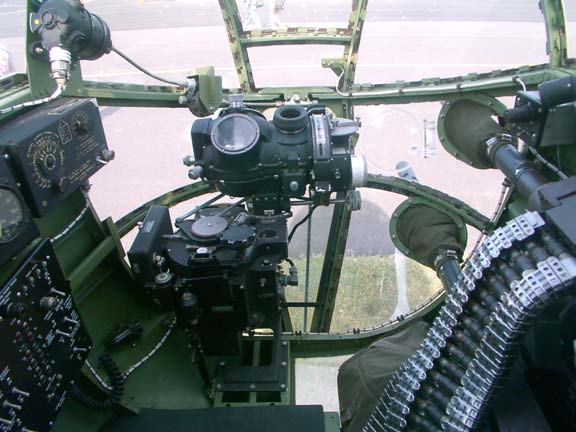
Bombardier's position in nose of B-25 Mitchell, Norden bombsight in center, Stabilizer below left. Mid-Atlantic Air Museum: http://www.maam.org/airshow/b25_nose.htm
Massey Air Museum has on display a Norden Bombsight such as would have been used by the bombardier on a B-17 Bomber (and other U.S. high altitude bombers) during WWII.
The Norden was able to determine, from variables input by the bombardier, the point at which the aircraft's bombs should be released to hit the target. It combines two primary functions: aiming and stabilization of the airplane in flight during the bomb run through the autopilot, plus bomb release.
At Massey you will see the upper unit, called the sighthead containing a gyroscope, sighting telescope and analog computer. This unit was initially classified ''Secret'' prior to the war. Gen. Hap Arnold insisted on it's removal and storage under armed guard when not installed in the airplane, which was done just prior to each mission. A unit called the ''stabilizer'' (which we do not have) always remained in the airplane, it contains another directional gyro which is connected to the sighthead. The autopilot enabled a bomber to be flown on a straight, level course, giving the bombardier a steady platform on which to operate the bombsight during the bombing run.
The complete bombsight consists of both of these mechanisms, lower unit or stabilizer, and the Norden upper unit. The stabilizer keeps the line-ofsight direction fixed, or controlled. It is coupled to the airplane's autopilot so it could actually fly the aircraft during the bombing run, and to the bomb racks so the Norden could release the bombs at the right time automatically when directed by the upper unit.
The telescope sight is used by the bombardier to locate the target long in advance of the drop point. The gyroscopes hold the bombsight stable. The computer solves the various mathematical problems which confront the bombardier just prior to the bombing run. The bombardier still had to consult tables and make numerous calculations before he could do the presets, he "dialed in" the Norden with the altitude and trail for the bomb type being used plus direction headings into the Auto-Pilot (sort of like setting up your computer the first time) for each and every bomb run.
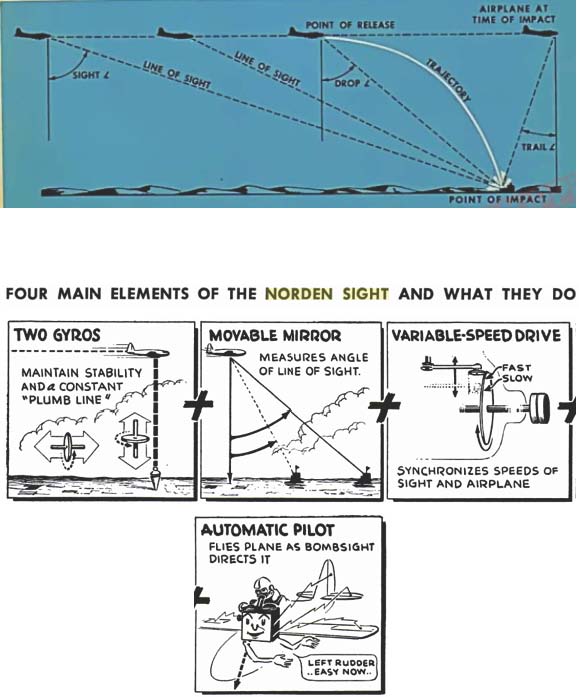
For a bomb drop to be successful, a three dimensional space plus time problem must be solved. The bomber must be steered to that point in space and at the correct time so that a dropped bomb will hit the target. The input parameters to this problem are true airspeed, altitude above the target, wind, and the ballistic characteristics of the bomb to be dropped. The bombardier computed the point in space, in two dimensions, and the Norden bombsight steered the bomber to that point. The bombsight compensated for the effects of headwind, tailwind, and crosswind. The electromechanical computer continuously solves for the present angle to the target as the bomber flies toward the target, compares this angle to the precomputed dropping angle, and released the bomb when these two angles were equal.
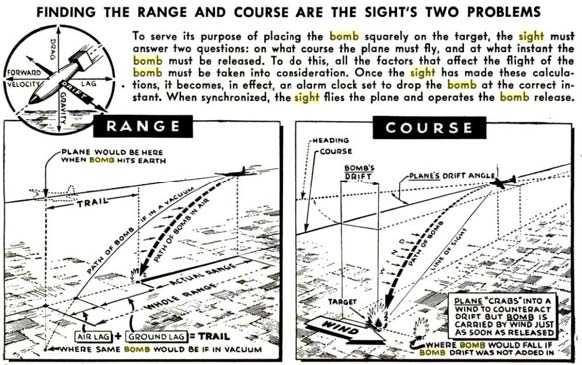
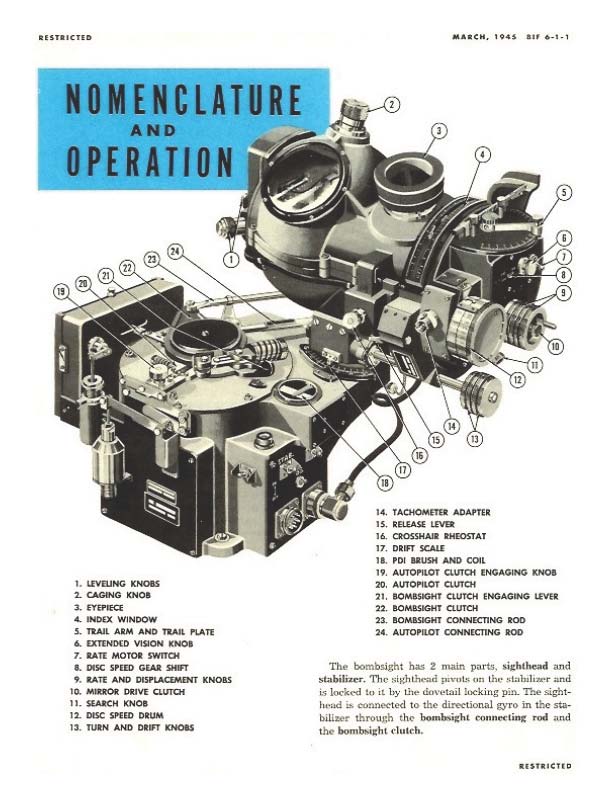
MASSEY'S NORDEN BOMBSIGHT (captioned photo below)
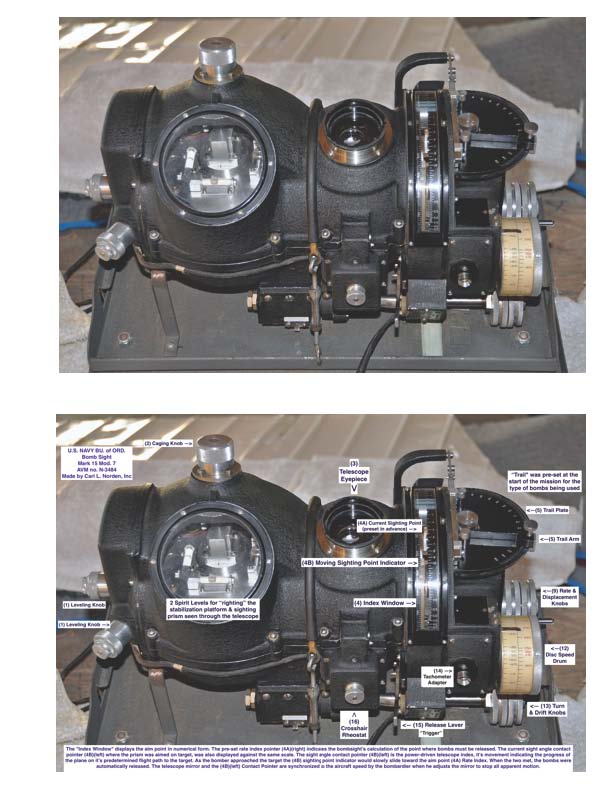
Great Expectations from World War II Magazine, January 2009 (Link)
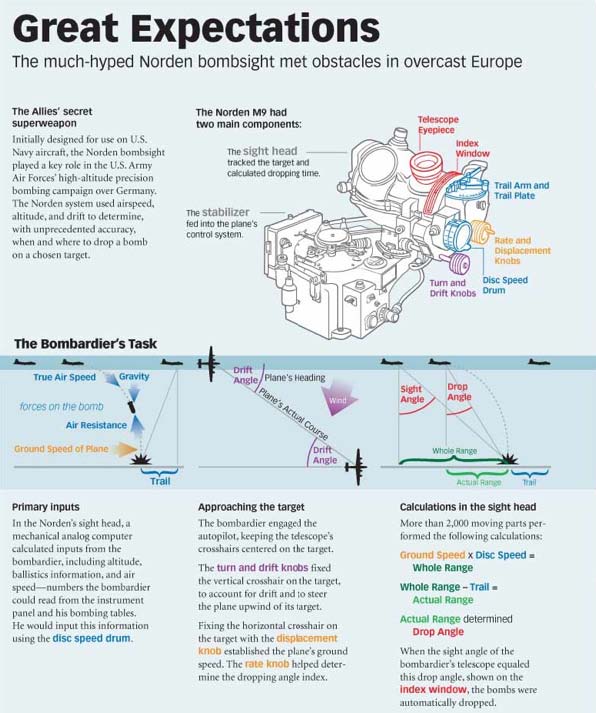
Bombing Accuracy from World War II Magazine, January 2009 (Link)
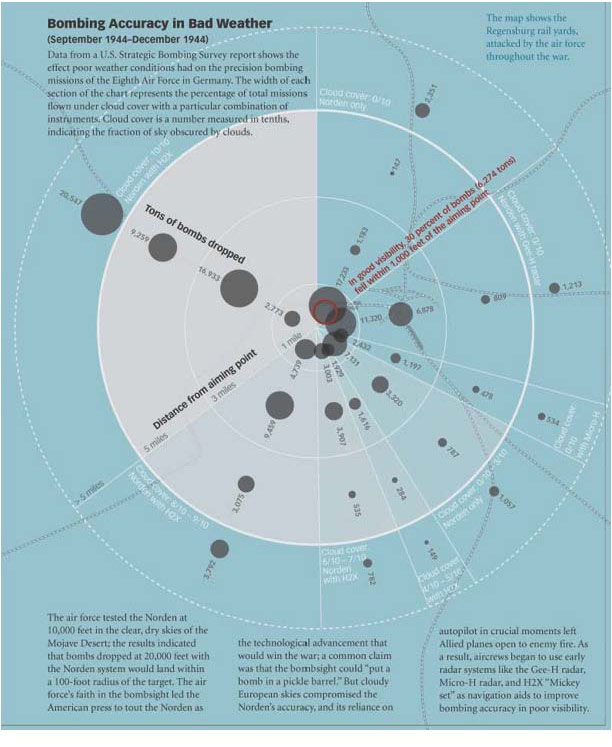
Norden Bombsight & Stabilizer lower left (Autopilot -Stabilized Bombing Approach Equipment)
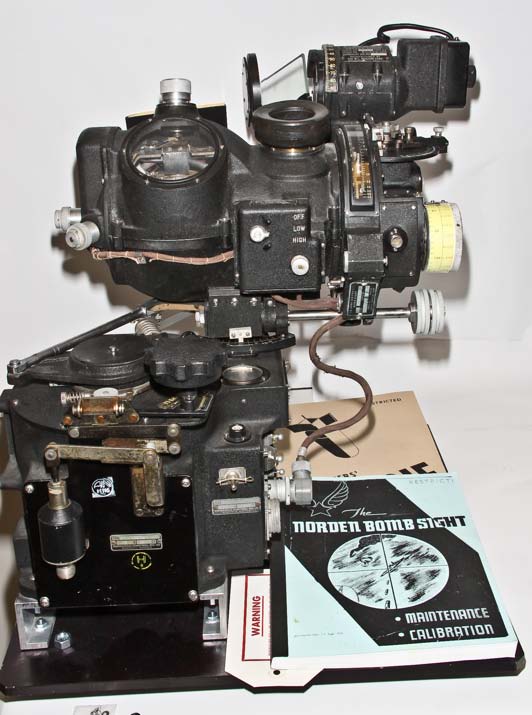
DEMYSTIFYING THE NORDEN BOMBSIGHT
Norden Bombsight (Mark 15, Mod. 7) - Made by Carl L. Norden, Inc.
Massey Air Museum has on display a Norden Bombsight such as would have been used by the bombardier on a B-17 Bomber (and other U.S. high altitude bombers) during WWII. It combines two functions, aiming and stabilization of the airplane in flight, it's autopilot actually flew the airplane during the bomb run.
You are looking at the upper unit, the sighthead or ''football'' containing gyroscopes, sighting telescope and analog computer. A second unit called the ''stabilizer'' or SBAE (which we do not have and which would remain in the airplane) contains a directional gyro which is connected to the sighthead.
In the 1930s, Air Corps planners refined the concept of high-altitude daylight precision bombing of strategic targets. Two essential components of this concept were the Norden bombsight and the self-defending heavy bomber. Prior to our entry into WWII, the exalted reputation of the Norden Bombsight was being promoted by the Air Corps because it served as a tool to justify the expansion of the U.S. Army Air Corps. The doctrine of high-altitude, daylight precision bombing promised, in addition to efficiently destroying the enemy, to save the lives of our airmen and importantly, save the lives of civilians on the ground. The Norden also offered a means to help maintain the morale of airmen flying the most dangerous missions of the war by justifying their sacrifices in the knowledge that they had the best tools to effectively fight the enemy -they well needed the reassurance that their lives weren't being needlessly wasted.
The Norden bombsight was deployed on B-17, B-24, B-25, and A-26 aircraft in the European and Pacific Theaters in WWII. B-29s with specially modified Norden bombsights dropped the atomic bombs on Japan in 1945.
The Norden calculated the bomb drop point, aimed the plane while compensating for wind drift and the SBAE (Stabilized Bombing Approach Equipment) stabilized the aircraft, controlling it for the final few minutes of the bomb run when the Norden would automatically release the bombs.
The legendary Norden bombsight (NBS), was an electro-mechanical analog computer deployed by the Allies during World War II for high altitude precision bombing. The Norden sight was designed by Carl Norden, a Dutch engineer educated in Switzerland who emigrated to the U.S. in 1904. He designed the prototype Mark 15 bombsight in 1930 for the U.S. Navy. Between 1935 and 1938, Norden also developed a mechanical autopilot that attached to the bombsight and the airplane's controls -the SBAE (Stabilized Bombing Approach Equipment). The complete bombsight actually is both these two mechanisms -a lower unit or directional stabilizer, and an upper unit, ''The Norden Bombsight,'' consisting of a number of assemblies, most important of which are the telescope, the computer and the gyros.
Almost 90,000 bombsights were built at a cost $8800.00 each plus the SBAE @ $4200.00 for a total of $13,000.00 in 1942 dollars. The entire program cost $1.1 Billion then or $17 Billion in 2016 dollars. For comparison the Manhatten Project would have cost $34 Billion today (the Norden equipment thus cost half that of developing the Atomic Bomb plus the 46 specially modified B-29 bombers of the 509th Composite Bombing Group).
Many myths surround the Norden, the Norden Company itself unashamedly promoted the bombsight as being accurate enough to drop a bomb in a pickle barrel from 20,000 feet -yet in ideal, clear and calm weather testing it could barely get within 100' of the target from 10,000' altitude. Supposedly the crosshair sight was made from a Black Widow spiders's web or alternately from the hair of one particular young woman from the midwest who had never cut her hair before -actually the crosshair was diamond etched.
The Norden reputation was enhanced by the occasional overzealous commander who was trying to impress young trainees with the seriousness of security by requiring that they take the ''bombardier's oath'' to protect the American Bombsight with their life itself, if need be. Gen. Hap Arnold did insist that it always be covered from view when being transported back and forth from the ''bomb vault'' to the aircraft before and after each mission. Initially classified as ''secret'' (''disclosure would endanger the national security''), this was reduced to ''confidential'' (''prejudicial'') in 1936 to facilitate development and manufacture. This was reduced again in Nov. 1942 to ''restricted'' (the lowest classification -''for official use only, access denied to the general public'').
Navy regulations specified the means for destroying the bombsight to prevent it's capture: ''Two rounds with a .45 caliber service pistol into the rate end mechanism… and one round through the telescope,'' and (if possible) throwing it overboard were acceptable means of destruction, though manuals explaining this technique failed to consider the possibility of ricocheting bullets. The Army seems to have developed a thermite bombsight destroyer device consisting of an 18'' x 5.5'' steel cylinder packed with 15 lbs. of magnesium and oxygenator but, if so, I cannot find any record of it being deployed, one couldn't afford an accidental ignition in flight as it would very likely take down the aircraft -perhaps just another myth?
It is curious as to why our military insisted on all these stringent security measures when the FBI knew by 1941 that the Nazi's had already obtained the secret. In July 1940 the FBI learned that Hermann Lang, a German national working for Norden had been ordered to return to Germany by the German Abwehr Luft spy agency. He was arrested in June 1941 and while he pleaded not guilty, court testimony revealed that Lang had provided drawings to a Nazi spy for $3500.00. The spy smuggled these drawings to Germany starting in Nov. 1937. Luftwaffe engineers then built and tested a model. During Lang's trial (Sept. 1941 -April 1942) The New York Times reported ''the secret of the Norden Bombsight, this country's most jealously guarded air defense weapon, has been in the hands of the German Government since 1938…'' The Germans never manufactured it, in part because their airpower doctrine did not include high altitude bombardment, rather they concentrated on medium to low altitude and dive bombing.
Much controversy surrounds the reputed accuracy of the Norden bombsight and there was found to be a large difference between the ideal conditions of the test range and actual combat conditions. Keep in mind that the Norden was a mechanism of extreme complexity requiring close tolerances far greater than a fine watch, it was built in mass quantities for use in temperature extremes down to -20°F above 20,000 feet and required a highly trained technician to operate -the bombardier. Rough handling was unavoidable, a hard landing or turbulence could flat-spot the gyro bearings sufficiently to require an overhaul. The units demanded almost constant recalibration to maintain accuracy. Undoubtedly many missions were flown by less than proficient bombardiers with the Norden out-of-specification. In good visibility only 30% of bombs fell within 1,000 feet of the aiming point and on average less than 10% fell within 1,200 feet.

The major drawback of an optical sight was that the bombardier required visual contact with the ground. Poor results and unacceptable attrition would force the USAAF to switch from precision to ''Saturation or Area bombing,'' although still in daylight. Radar and radio navigation, although primitive by today's standards, would improve bombing accuracy in the cloudy skies over Europe but not until late in the war.
Prewar American air doctrine was based on the presumption that an attack on the economic heart of the enemy's country would result in a quick and relatively bloodless victory. To achieve this envisioned strategic victory, AAF leaders believed that the optimal strategy was a daylight precision bombing campaign directed at the enemy's war economy. However, they had not taken into consideration the European weather or wartime advances in German aircraft, weapon design and strategy. The use of 30-millimeter long-range cannons allowed Luftwaffe pilots to engage the high altitude bombers effectively from outside the range of the .50 caliber guns utilized by the Americans.
The post war United States Strategic Bombing Survey also found that poor strategic planning, lack of Allied coordination and dispersal of German manufacturing added to the lack of results -in particular, the failure to press home the strikes on war production industries. When asked how decisive effects could have been achieved against the ball -bearing industry Albert Speer, the Reich's Minister of Armaments, had a ready answer. ''If all the plants had been attacked at the same time and if area attacks had been included and repeated three or four times at intervals of 14 days, in conjunction with follow-on attacks every eight weeks to deter reconstruction and sustained for a period of six months,'' he said, ''then production would have been brought to a standstill and paralyzed thousands of armament plants.'' The Chief German electrical engineer stated that the war would have been finished two years sooner if attacks had been concentrated on German electric power plants, which were thought by the strategists to be physically too small a target and too dispersed for successful bombing. In 1943 targeting, electrical power was prioritized fourth, preceded by the German air force, submarine construction, and transportation, later it was demoted to 13th behind military targets. The objective of the Allied air strategists did not necessarily correlate to the overall objective in the Allies' grand strategy. Target priorities were continually changed based on operational necessity (i.g. the invasion of Normandy). This often detracted from the overall effectiveness of the bomber units. There weren't enough clear days! (Destruction of heavy manufacturing machines required bombs striking within 100' or less, often the plants were able to keep operating after the roofs had been blown off).
World War II witnessed the first full application of strategic airpower in war. Allied air forces dropped nearly 2.7 million tons of bombs, flew 1,440,000 bomber sorties and 2,680,000 fighter sorties. The number of men lost in air action was 79,265 Americans and 79,281 British. More than 18,000 American and 22,000 British planes were lost or damaged beyond repair. Bombing raids on Germany destroyed 3,600,000 dwellings; approximately 20 percent of the total number of buildings in that country were destroyed or heavily damaged. Survey estimates showed between 400,000 & 600,000 Germans killed and 780,000 wounded. The number made homeless reached 7,500,000. Allied bombing reduced the principal German cities largely to hollow walls and piles of rubble.
Allied airpower pursued a war winning strategy through strategic bombing. However, despite the tremendous punishment inflicted, from a standpoint of coercion, strategic bombing failed to force Germany to surrender.
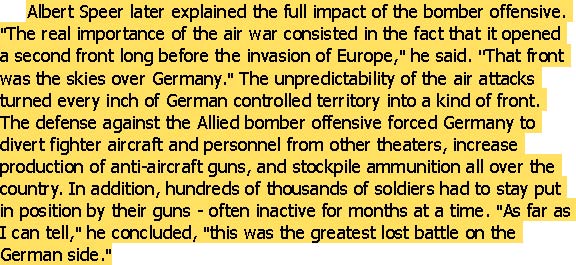
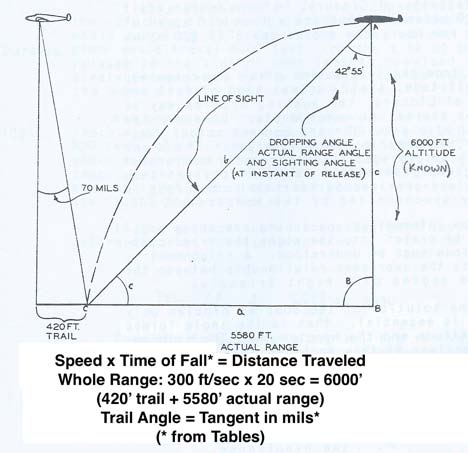
For a bomb drop to be successful, a three dimensional space plus time problem must be solved. The bomber must be steered to that point in space and at the correct time so that a dropped bomb will hit the target. The input parameters to this problem are true airspeed, altitude above the target, wind, and the ballistic characteristics of the bomb to be dropped. The bombardier computed the point in space, in two dimensions, and the Norden bombsight steered the bomber to that point. The bombsight compensated for the effects of headwind, tailwind, and crosswind. The electromechanical computer continuously solves the present angle to the target as the bomber flies toward the target, compares this angle to the precomputed dropping angle, and released the bomb when these two angles were equal. The Norden bombsight is stabilized in pitch and roll by 1) the autopilot stabilization of the bomber and 2) two gyroscopes in the bombsight that provided additional stabilization. Bombs are released, on signal from the Norden bombsight, in one of four modes: salvo or train, armed or unarmed.
Following is verbatim out of the Maintenance Technician's Training Manual, Note the appeal to the soldier's patriotism to do a good job both for their Countrymen and the Country.
The Norden Bomb Sight Maintenance / Calibration Manual Introduction:
''Upon the shoulders of the bombsight maintenance personnel rests the responsibility of accurate calibration and maintenance and to that extent the success or failure of a bombing mission.
You cannot and must not make any attempt to shift that responsibility. You are a soldier of the United States Army Air Forces. Uphold the tradition and heritage of your Country, your branch of the Service and Victory will be ours.''
Section X CALIBRATION -Introduction (p.179):
''If it were possible to single out any weapon of war as the most vital for victory, doubtless the airplane would be chosen. And the bombardment plane occupies the central position in any air force. The fighter planes exist largely to afford protection to our bombers when on a mission or to intercept enemy bombers when they are directed against us. Therefore the fighter is auxiliary to the bomber….
The bomber exists to drop bombs. The bombsight is the instrument by which it is enabled to do so with any degree of accuracy… And, of course the accuracy and operation of the bombsight depend directly upon the effectiveness of the bombsight maintenance man….
It may well be that faulty work on his part may result in nullifying the entire mission and even in loss of the bomber and her crew…. No American soldier wants to think he could be responsible for such a disaster. Conscientious application to his work will make it unnecessary for his mind ever to dwell upon such a thought, for it is possible on every mission to make certain the bombsight will function and will function accurately.''
William G. Dougherty (Above Emphasis mine) Sources: America's Pursuit of Precision Bombing 1910-1945 by Stephen L. McFarland, Wikipedia, Popular Science June 1945 ''How the Norden Bombsight Does it's Job,'' Popular Mechanics Feb. 1945, Bombardier's Information File (BIF), AAFRadio http://aafradio.org/NASM/ Bombardiers_Station.htm , Glenn's Computer Museum http:// www.glennsmuseum.com/bombsights/norden.html , ''Weapons Manual'' by Max Gadney World War II Jan. 2009, B-25 Bombardier's position http://www.maam.org/airshow/b25_nose.htm , THE STRATEGIC BOMBING CAMPAIGN AGAINST GERMANY DURING WORLD WAR II http://etd.lsu.edu/docs/available/etd-0413102-132317/unrestricted/ Rigole_thesis.pdf , Strategic Attack of National Electrical System http:// www.comw.org/pda/fulltext/griffith.pdf , Spandau: The Secret Diaries by Albert Speer.
================================================= =================================================
Some WWII Facts:
World War II cost the United States $345 Billion in 1945 dollars = $4.5 trillion in 2016 dollars -seems cheap doesn't it?
(Compare this to the estimated $4 trillion cost of the 2nd Iraq War at $1.6 to $2 trillion plus $2 trillion more in Veteran's medical and disability
expenses. http://www.reuters.com/article/us-iraq-war-anniversary-idUSBRE92D0PG20130314 & http:// time.com/3651697/afghanistan-war-cost/ )
USAAC-USAAF Military Personnel Strength
Total Peaked at 2,411,294 in March 1944 Overseas Peaked at 1,224,006 in April 1945
88,119 airmen died in service. 52,173 were battle casualty deaths: 45,520 killed in action , 1,140 died of wounds, 3,603 were missing in action and declared dead, and 1,910 were non-hostile battle deaths. Of the United States military and naval services, only the Army Ground Forces suffered more battle deaths. 35,946 non-battle deaths included 25,844 in aircraft accidents, more than half of which occurred within the Continental United States. 63,209 members of the USAAF were other battle casualties. 18,364 were wounded in action and required medical evacuation, and 41,057 became prisoners-of-war . Its casualties were 5.1% of its strength, compared to 10% for the rest of the Army. (Wikipedia)
Total aircraft losses for the AAF from December 1941 to August 1945 were 65,164, with 43,581 lost overseas and 21,583 within the Continental United States. Combat losses of aircraft totaled 22,948 worldwide, with 18,418 lost in theaters fighting Germany and 4,530 lost in combat in the Pacific. (Wikipedia)
| Aircraft Combat Losses in the ETO in World War II: | |
|---|---|
| http://www.taphilo.com/history/8thaf/8aflosses.shtml | |
| Aircraft | Number |
| Type | Lost |
| B-17 | 4,754 of 12,731 built |
| B-24 | 2,112 of 16,188 built |
| P-47 | 1,043 of 15,660 built |
| P-38 | 451 of 10,037 built |
| P-51 | 2,201 of 15,586 built |
Total 10,561
Around 30,000 members of the 8th, 9th, 11th, 12th, and 15th Army Air Forces died in the ETO / MTO. Around 14,000 were wounded and some 33,000 were captured and spent some time as Kriegies in a POW camp anywhere from North Africa to the Baltic.
Around 135,000 men flew in combat in the 8th Air Force.
American Air Force airplane losses worldwide during World War II: 27,694 aircraft, including 8,314 heavy bombers, 1,623 medium and light bombers, and 8,481 fighters as destroyed in combat.
1941-1945 Stateside Training Accidents
47,462 Aircraft all types
5,533 Fatal Accidents 13,621 Fatalities 12,506 Airplanes Wrecked
12,731 B-17s built -50 are left in the world & 12 are still airworthy. 16,188 B-24s were built -only 1 still flies.
Boeing B-17 Flying Fortress Bomb Loads
B-17 Bomb load-out: quantity of bombs x weight of bomb (in pounds). B-17F&G:2x2000,2x1600,2x1000,12x500,16x300, 16x250,24 x 100.
- Short range missions (<400 mi): 8,000 lb
- Long range missions (>800 mi): 4,000 lb
- Overload: 17,600 lb
A 4000 lb. bomb load was the maximum for a long range mission (i.g. Berlin) with full fuel, a heavier load could be carried to closer targets. So we were risking 10 men to deliver only 2 tons of bombs on Germany: 8 -500 lb. bombs -over 90% of which missed their target.
Maximum load comparison: B-17 max. 12 -500 lb. = 6,000 lb. B-24 max. 8 -1000 lb. = 8,000 lb. B-29 max. 40 -500 lb. = 20,000 lb. B-52 max. 51 -750 lb. = 38,250 lb. (42,732 lb. max. other types)
The British Lancaster bomber could carry 28 -500lb. bombs = 14,000 lb. (some variants could carry the 24,000 pound Grand Slam)
=================================================
Death of the Ball Turret Gunner
From my mother's sleep I fell into the State,
And I hunched in its belly till my wet fur froze.
Six miles from earth, loosed from its dream of life,
I woke to black flak and the nightmare fighters.
When I died they washed me out of the turret with a hose.
Poem by Randall Jarrell
===========================================
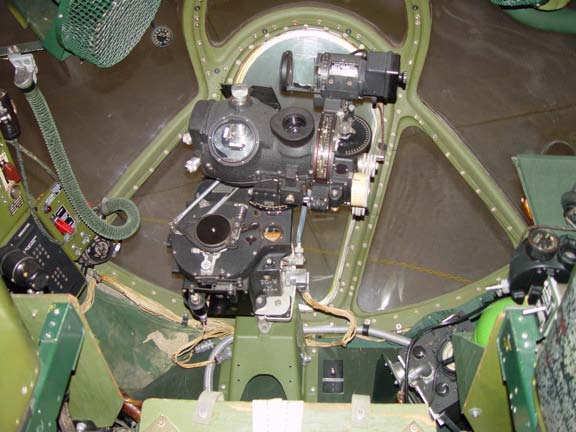
Bombardier's position in nose of B-29, Norden bombsight in center, connected to Stabilizer below left.
2016, Massey Air Museum
